The X25-M was a tremendous first attempt by Intel to get into the SSD market. In our review of the SSD I wrote that Intel just Conroe’d the SSD market, and if it weren’t for the pesky 80MB/s sequential write speed limitation the X25-M would’ve been given the title: World’s Fastest Drive.

Its successor, the X25-M G2, was a mild update that brought prices down through the use of 34nm NAND. Remember that Intel is also 49% owner of the IMFT joint venture and as a result can be quite competitive on NAND pricing (and quite early to adopt new NAND technologies).
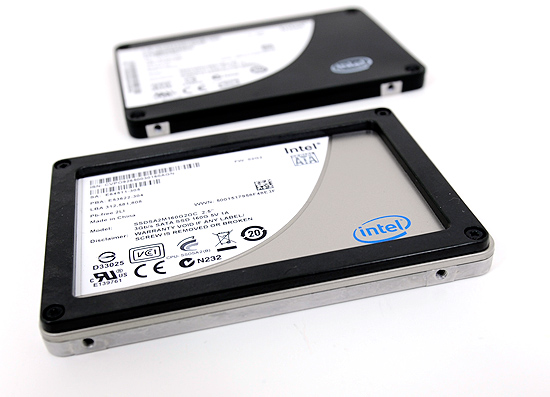
Intel’s goal all along was to drive down the cost of SSDs. Looking at the history of MSRPs with the X25-M (not to mention the M, which stood for Mainstream in the product name) this shouldn’t come as a surprise:
| Intel X25-M Pricing History | |||||||||||||||||||||||||||||||||||||||||||||||||||||||||||||||||||||||||||||||||||||||||||||||||||||||||||||||||||||||||||||
| 2008 | 2009 | ||||||||||||||||||||||||||||||||||||||||||||||||||||||||||||||||||||||||||||||||||||||||||||||||||||||||||||||||||||||||||||
| 40GB | - | $125 | |||||||||||||||||||||||||||||||||||||||||||||||||||||||||||||||||||||||||||||||||||||||||||||||||||||||||||||||||||||||||||
| 80GB | $595 | $225 | |||||||||||||||||||||||||||||||||||||||||||||||||||||||||||||||||||||||||||||||||||||||||||||||||||||||||||||||||||||||||||
| 160GB | $1000+ | $440 | |||||||||||||||||||||||||||||||||||||||||||||||||||||||||||||||||||||||||||||||||||||||||||||||||||||||||||||||||||||||||||
The third generation X25-M was to drive down costs even further, this time thanks to Intel’s 25nm NAND. You’d be able to get twice the capacity at the same price point as the X25-M G2. The value drive would be an 80GB offering, the mainstream drive would be 160GB and the high end drive would be 320GB.
The drive would offer higher performance. The controller was to be completely redesigned, with the “oversight” that limited sequential write speed to only 100MB/s corrected entirely. In addition, the third generation Intel SSD would add full disk encryption - making it even better suited for enterprise customers. Going after the enterprise market was Intel’s plan to really make money on SSDs in the long run. Instead of just selling corporations a CPU, chipset and wireless controller in a notebook, there would be an SSD on top of all of that. Perhaps eventually even have some security software courtesy of McAfee.
The third generation X25-M was originally due out in the middle of 2010. As is usually the case with schedules, the “G3” slipped. The middle of the year became the end of the year and the end of the year became Q1 2011.
To make matters worse, the specifications Intel was talking about for its third generation drive/controller weren’t all that competitive. Intel’s redesigned controller was late and underperforming. Internally, Intel knew it had a problem.
Intel aimed for the majority of the market with the X25-M, it had set its sights on lowering cost, but it left the high performance enthusiast market entirely uncared for. A void that SandForce filled quite nicely with its unique brand of controllers.
With a hole in the roadmap and an unwillingness to cede complete control of the high end market to SandForce, Intel did the unthinkable: developed a new SSD based on a competing controller technology.
Intel’s SSD 510 Powered by Marvell
At IDF 2008 Intel presented a session that discussed its SSDs and what made them better than the competition. Allow me to quote, ahem, myself:
“Intel's SSD design attempts to be different in the three key areas that determine SSD performance: Flash, Firmware and Controller.”
and
“The Firmware and Flash-to-SATA controller are both made by Intel, whereas most SSD makers use off the shelf components and FPGAs for their designs. Intel claims that its expertise in microprocessor and platform design allows for much higher levels of performance out of its SSDs.”
Now allow me to contrast what Intel told me at IDF 2008 with the reality of today in 2011.
The “G3” we’ve all been waiting for will still come. That’ll be Intel’s first 25nm SSD and it should carry specs similar to what we already published. However the focus of the drive will be the mainstream. To take care of the high end Intel created a new drive: the Intel SSD 510 (codename Elmcrest) and it uses a Marvell 9174 6Gbps controller.
Everyone has access to the same NAND that Intel does, but in the past it was controller microarchitecture and firmware that gave Intel the edge. With the 510, the advantage has been reduced to just firmware.
The Marvell 9174 is the same controller Micron uses in its C400 and the same controller in Corsair’s Performance Series 3 SSDs. In fact, I recently received a Corsair P3. Pop off the lid and you’ll see the very same controller Intel is using in the 510:
Talk to SandForce and they’ll tell you that the controller itself doesn’t matter - it’s the firmware that matters the most. That’s definitely true to an extent, although I can’t help but feel like you need both microarchitecture and firmware to get the absolute best performance.
Although the controller is sourced from Marvell the firmware and validation are entirely Intel’s. As a result you shouldn't expect the 510 to perform identically to other Marvell based drives.
Intel is also quick to point out that despite using a 3rd party controller, the 510 has to go through Intel’s rigorous validation and testing. Reliability and quality should be no different than any other Intel SSD.
I asked Intel if this was a permanent thing - if we should always expect it to license controllers from third parties for its high performance SSDs. Intel responded by saying that the Marvell controller made sense given the hole in its roadmap, however this is not a long term strategy. While we may see more Intel SSDs based on 3rd party controllers, Marvell’s controller is not a permanent resident in Intel’s SSD roadmap - it’s just here on a student visa.
Paired with the Marvell controller is a 128MB Hynix DDR3-1333 SDRAM. This is technically the largest DRAM to appear on an Intel SSD to date. Even the old X25-M G2 only had a 32MB DRAM on board.
The 510 currently only supports 34nm Intel NAND rated at 5,000 p/e cycles. There are two capacities offered: a 120GB and a 250GB. Intel sent us the 250GB version which has 256GB of 34nm Intel NAND spread out across 16 NAND packages. That’s 16GB per package and 4GB per 34nm die.
Remember the GiB/GB conversion math that’s used to mask spare area in SSDs. With 256GiB of NAND on board and 250GB of storage area promised by the drive, there’s actually only 232.8GiB of user addressable space on the 250GB drive. This puts the percentage of spare area at 9%, an increase over the 6.8% spare area common on the X25-M.
The 120GB drive has even more spare area than the 250GB drive. With 128GB of 34nm NAND on board, the 120GB Intel SSD 510 has 111GiB of user addressable space for a total spare area of 12.7%.
Intel’s rated performance for the SSD 510 is as follows:
| Intel SSD Comparison | |||||||||||||
| X25-M G2 160GB | SSD 510 120GB | SSD 510 250GB | |||||||||||
| NAND Capacity | 160GB | 128GB | 256GB | ||||||||||
| User Capacity | 149GB | 111GB | 232GB | ||||||||||
| Random Read Performance | Up to 35K IOPS | Up to 20K IOPS | Up to 20K IOPS | ||||||||||
| Random Write Performance | Up to 8.6K IOPS | Up to 8K IOPS | Up to 8K IOPS | ||||||||||
| Sequential Read Performance | Up to 250MB/s | Up to 400MB/s (6Gbps) | Up to 500MB/s (6Gbps) | ||||||||||
| Sequential Write Performance | Up to 100MB/s | Up to 210MB/s (6Gbps) | Up to 315MB/s (6Gbps) | ||||||||||
| Price | $404 | $284 | $584 | ||||||||||
Ironically enough the SSD 510 fixes the X25-M’s poor sequential performance but trades it for lower random performance. On paper the 510’s random performance is decidedly last-generation. And honestly the rated performance of the 120GB isn’t particularly interesting. The 120GB drive will have fewer NAND die available, and SSDs achieve their high performance by striping data requests across as many NAND die as possible - hence the lower performance specs.
Pricing is set at $284 for the 120GB drive and $584 for the 250GB drive. Intel’s SSD 510 is available today and Newegg marks the two up to $315 and $615 respectively.
The Bundle
Intel sent over the desktop installation kit bundle for the 510. Included in the box is a 3.5" adapter kit, a 6Gbps SATA cable (3Gbps cables of sufficient quality should work fine though) and a 4-pin molex to SATA power adapter:
The 510 also works with Intel's SSD Toolbox, which makes tasks like secure erase super simple:

A Word on Reliability
Marc Prieur has been around writing about hardware for as long as I can remember (think back to the old school Tom days). Late last year he published some particularly controversial numbers on his website: failure rates of various PC components according to a French etailer. Among the components were SSDs and the numbers are below:
| SSD Failure Rates - Hardware.fr | |||||||
| Intel | Corsair | Crucial | Kingston | OCZ | |||
| Failure Percentage | 0.59% | 2.17% | 2.25% | 2.39% | 2.93% | ||
I should add that the numbers Marc published were accurate (confirmed by some of the manufacturers involved), although they don’t paint the complete picture of world wide failure rates - they are an important sample to look at.
Other than Intel, none of the companies listed in that article were particularly pleased with the numbers.
I mentioned earlier that the 510 would go through Intel’s extensive validation testing, just like any other Intel product. Presumably this means that the SSD 510 should have similarly low failure rates in the field (unless there’s something horribly wrong with the Marvell controller that is). Compatibility should also be a strong point of the SSD 510 due to Intel’s stringent internal testing.
Note that I am separating reliability and compatibility from drive longevity. There’s typically a good correlation between high random write performance and low write amplification. The Intel SSD 510 doesn’t have particularly high random write performance, and in turn should suffer from fairly high write amplification in highly random workloads.
I’ve already proved in the past that at 5,000 p/e cycles there’s no cause for worry for a normal desktop user. The likelihood that you’ll wear out all of your NAND within the next 5 years is very, very low. However I will say that when faced with enterprise workloads you’re going to have to pay much closer attention to write amplification and spare area than you would on say a SandForce drive.
The Test
| CPU | Intel Core i7 965 running at 3.2GHz (Turbo & EIST Disabled) Intel Core i7 2600K running at 3.4GHz (Turbo & EIST Disabled) - for AT SB 2011, AS SSD & ATTO |
| Motherboard: | Intel DX58SO (Intel X58) Intel H67 Motherboard |
| Chipset: | Intel X58 + Marvell SATA 6Gbps PCIe Intel H67 |
| Chipset Drivers: | Intel 9.1.1.1015 + Intel IMSM 8.9 Intel 9.1.1.1015 + Intel RST 10.2 |
| Memory: | Qimonda DDR3-1333 4 x 1GB (7-7-7-20) |
| Video Card: | eVGA GeForce GTX 285 |
| Video Drivers: | NVIDIA ForceWare 190.38 64-bit |
| Desktop Resolution: | 1920 x 1200 |
| OS: | Windows 7 x64 |
Random Read/Write Speed
The four corners of SSD performance are as follows: random read, random write, sequential read and sequential write speed. Random accesses are generally small in size, while sequential accesses tend to be larger and thus we have the four Iometer tests we use in all of our reviews.
Our first test writes 4KB in a completely random pattern over an 8GB space of the drive to simulate the sort of random access that you'd see on an OS drive (even this is more stressful than a normal desktop user would see). I perform three concurrent IOs and run the test for 3 minutes. The results reported are in average MB/s over the entire time. We use both standard pseudo randomly generated data for each write as well as fully random data to show you both the maximum and minimum performance offered by SandForce based drives in these tests. The average performance of SF drives will likely be somewhere in between the two values for each drive you see in the graphs. For an understanding of why this matters, read our original SandForce article.
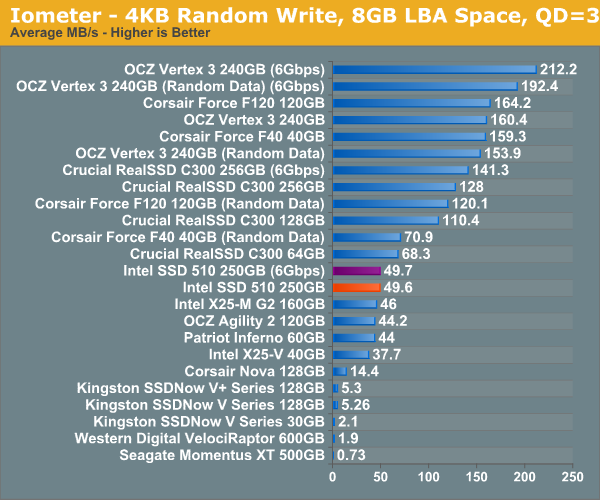
It's a bit unfortunate for Intel that we happen to start our performance analysis with a 4KB random write test in Iometer. The 510's random write performance is only marginally better than the X25-M G2 at 49.7MB/s. The RealSSD C300 is faster, not to mention the SF-1200 based Corsair Force F120 and the SF-2200 based OCZ Vertex 3.
Although not depicted here, max write latency is significantly reduced compared to the X25-M G2. While the G2 would occasionally hit a ~900ms write operation, the 510 keeps the worst case latency to below 400ms. The Vertex 3 by comparison has a max write latency of anywhere from 60ms - 350ms depending on the type of data being written.
Many of you have asked for random write performance at higher queue depths. What I have below is our 4KB random write test performed at a queue depth of 32 instead of 3. While the vast majority of desktop usage models experience queue depths of 0 - 5, higher depths are possible in heavy I/O (and multi-user) workloads:
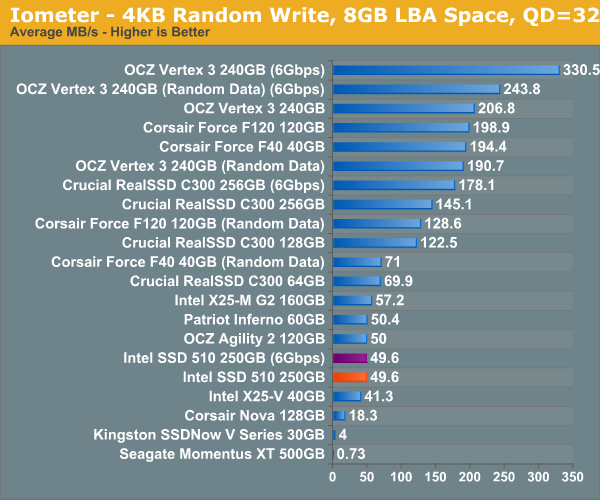
While the X25-M G2 scaled with queue depth in our random write test, the 510 does not. It looks like 50MB/s is the absolute highest performance we'll see for constrained 4KB random writes. Note that these numbers are for 4KB aligned transfers, performance actually drops down to ~40MB/s if you perform sector aligned transfers (e.g. performance under Windows XP).
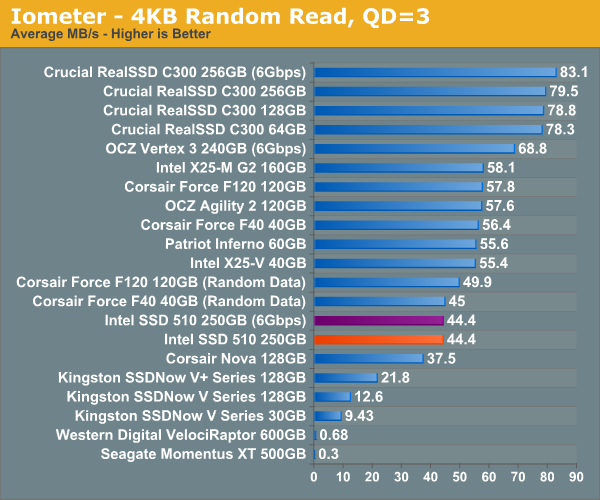
Random read performance is just as disappointing. The X25-M G2 took random read performance seriously but the 510 is less than 20% faster than the Indilinx based Corsair Nova. When I said the Intel SSD 510's random performance is decidedly last-generation, I meant it.
Sequential Read/Write Speed
To measure sequential performance I ran a 1 minute long 128KB sequential test over the entire span of the drive at a queue depth of 1. The results reported are in average MB/s over the entire test length.
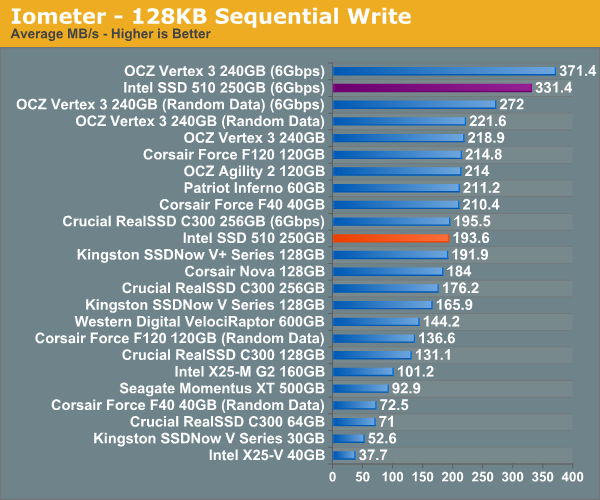
Sequential performance is another story entirely. When paired with a good 6Gbps SATA controller (in this case the H67's 6Gbps Port 1), the 510 is only 11% slower than the best case performance of the Vertex 3. Compared to the worst case performance for the Vertex 3, Intel's SSD 510 is 22% faster.
The comparison isn't as strong over a 3Gbps interface. Bound by the SATA interface, OCZ's Vertex 3's worst case performance is actually no different than its best case performance in 3Gbps mode. As a result, the Vertex 3 is consistently 13% faster than the Intel SSD 510.
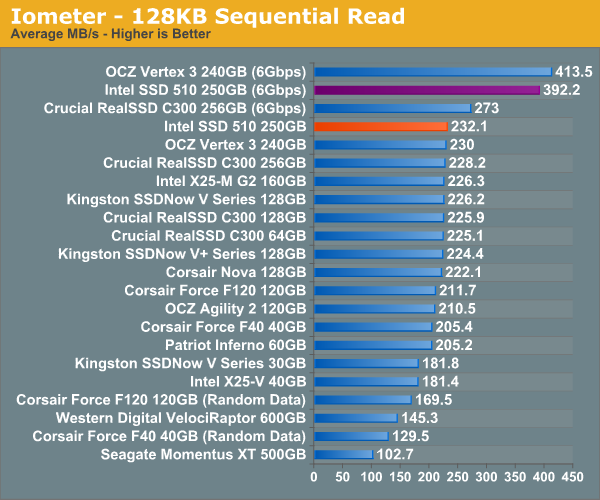
While the 510 isn't remotely competitive in random read performance, sequential read speed is within 5% of the OCZ Vertex 3 - without any real time compression/dedupe trickery. And over a 3Gbps interface the Intel SSD 510 equals OCZ's Vertex 3.
Performance vs. Transfer Size
All of our Iometer sequential tests happen at a queue depth of 1, which is indicative of a light desktop workload. It isn't too far fetched to see much higher queue depths on the desktop. The performance of these SSDs also greatly varies based on the size of the transfer. For this next test we turn to ATTO and run a sequential write over a 2GB span of LBAs at a queue depth of 4 and varying the size of the transfers.
It's very interesting to note how Intel's performance curve mimics that of the Vertex 3 down to the slight performance tradeoff at smaller transfer sizes. The RealSSD C300, despite being based on effectively the same controller as the Intel SSD 510, achieves much better small file sequential read speed. Intel/SF's optimization point likely makes more sense here however as sequential transfers generally happen at larger sizes (typically at 128KB).
At 128KB the Intel SSD 510 is slightly faster than OCZ's Vertex 3.
Write speed with fully compressible data is easily a victory for the SF-2200 based OCZ Vertex 3.
AS-SSD High Queue Depth Incompressible Sequential Performance
The AS-SSD sequential benchmark takes place at a very high queue depth of 32 and uses incompressible data for all of its transfers. The result is a pretty big reduction in sequential write speed on SandForce based controllers.
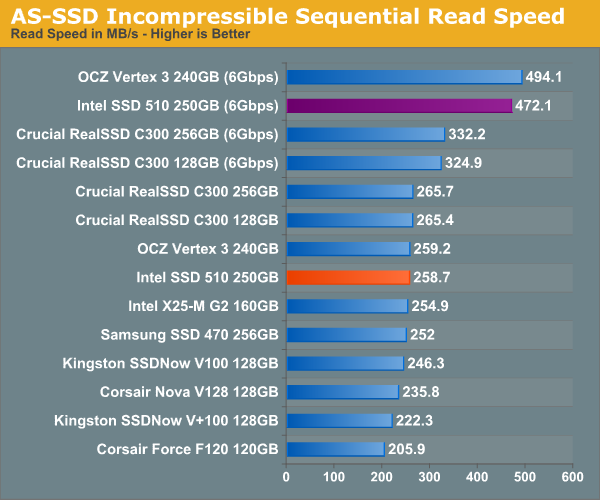
For all intents and purposes, worst case sequential read performance is identical between the Vertex 3 and Intel SSD 510.
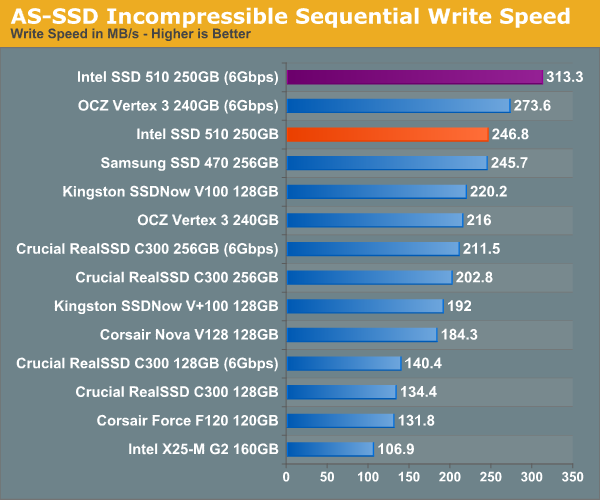
While ATTO showed us the Vertex 3 with a signficant advantage over the 510, AS-SSD gives us the other end of the spectrum. If you're going to be copying a lot of H.264 movies around on your SSD, the 510 will likely have better write performance than the Vertex 3. However if you're copying large databases around instead, the advantage will shift back to OCZ/SF.
Overall System Performance using PCMark Vantage
Next up is PCMark Vantage, another system-wide performance suite. For those of you who aren’t familiar with PCMark Vantage, it ends up being the most real-world-like hard drive test I can come up with. It runs things like application launches, file searches, web browsing, contacts searching, video playback, photo editing and other completely mundane but real-world tasks. I’ve described the benchmark in great detail before but if you’d like to read up on what it does in particular, take a look at Futuremark’s whitepaper on the benchmark; it’s not perfect, but it’s good enough to be a member of a comprehensive storage benchmark suite. Any performance impacts here would most likely be reflected in the real world.
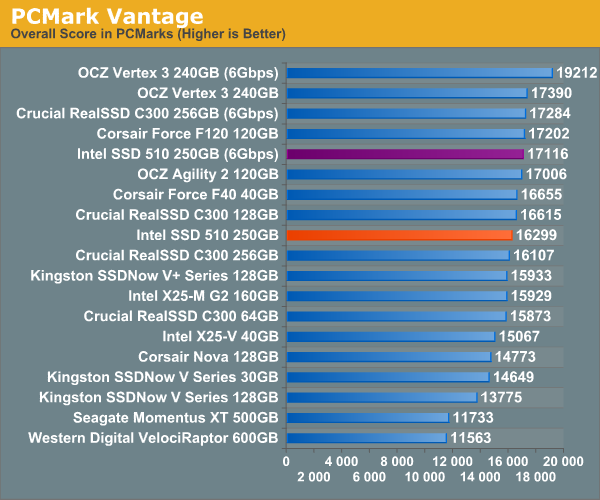
PCMark Vantage doesn't look too good paired with the 510. On a 6Gbps controller the Intel SSD 510 performs in line with the 3Gbps Vertex 3, however the 6Gbps Vertex 3 is untouchable. And over a 3Gbps interface the 510 is no better than a C300.
The pure HDD tests (below) are, at best, SF-1200 level. The SF-2200 is untouchable here. Based on what we've seen thus far I'm guessing this has a lot to do with the random read performance of the 510 once more.
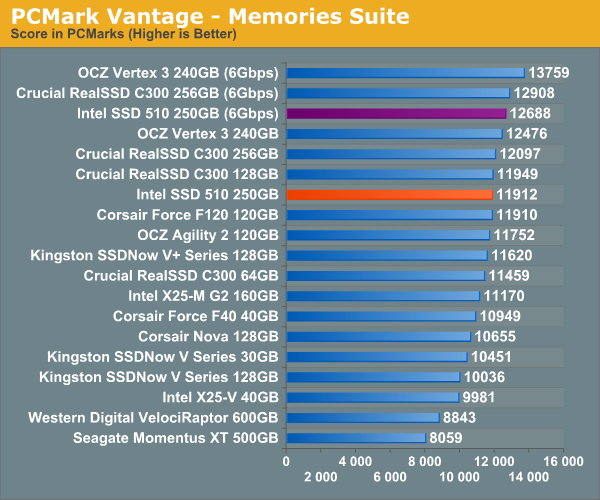
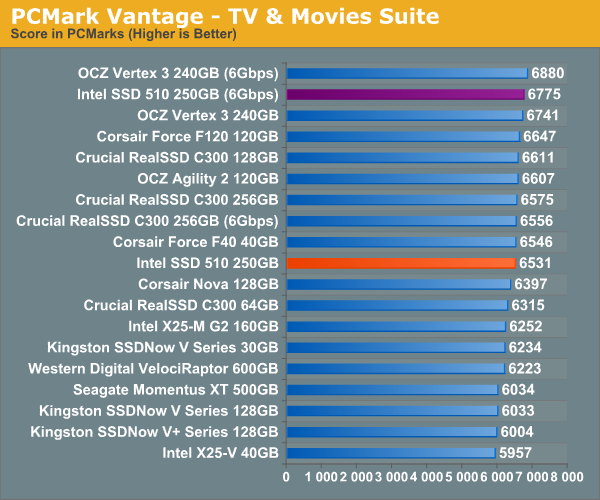
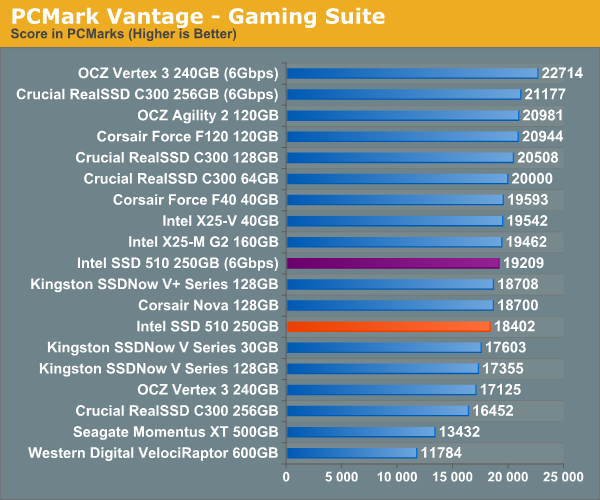

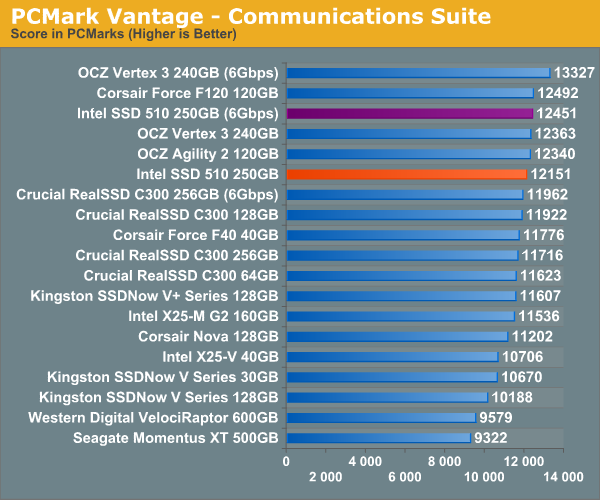
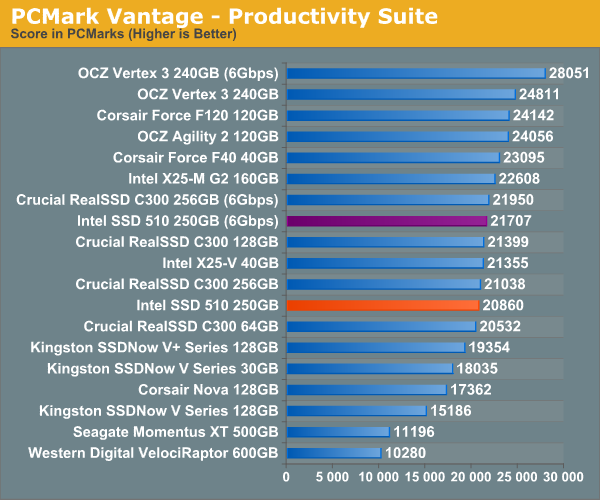
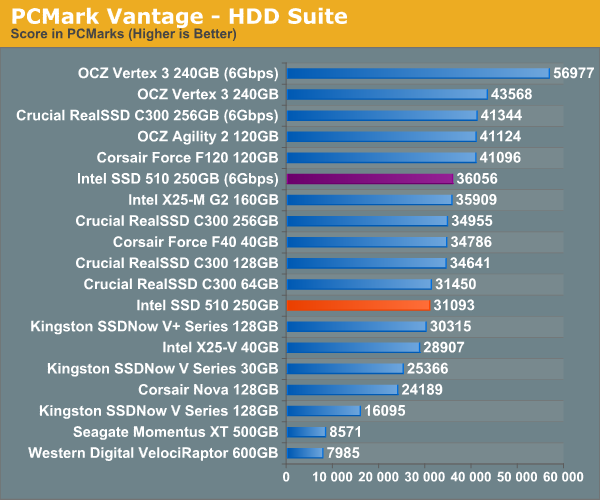
SYSMark 2007
SYSMark 2007 isn't nearly as demanding on the storage subsytem so we're mostly bottlenecked elsewhere. Here the Intel SSD 510 is easily close in performance to the Vertex 3.
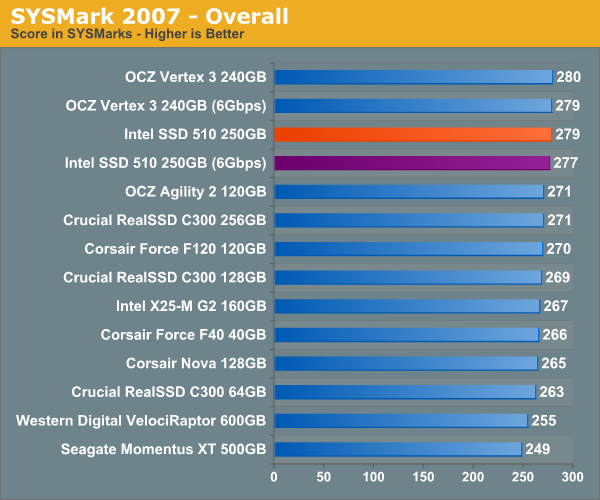
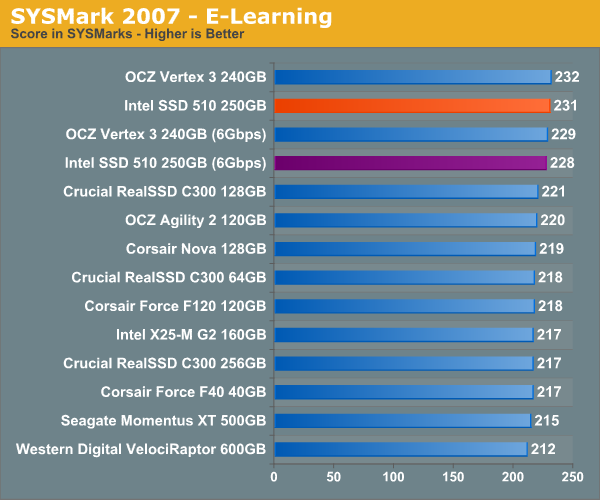
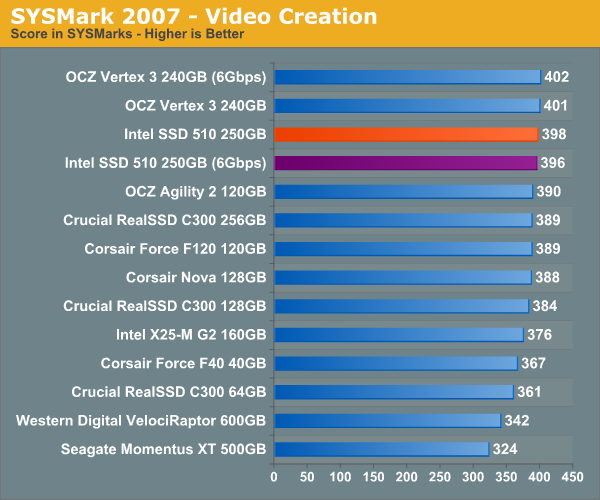

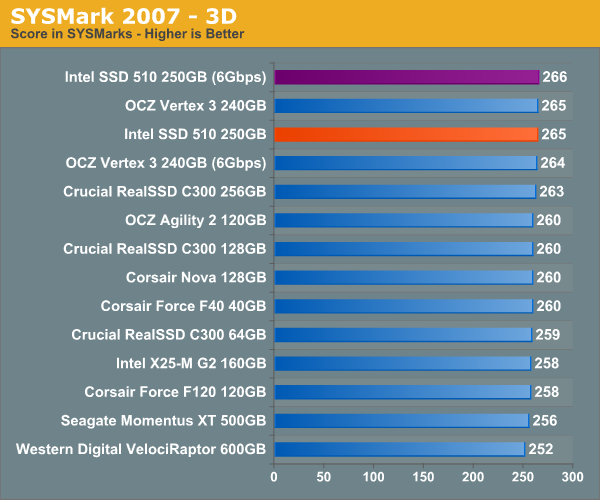
TRIM Performance
As expected, Intel's SSD 510 fully supports the ATA TRIM instruction. To gauge it's implementation I filled the 510 with data then ran a 4KB random write test (QD=32, 100% LBA space) for 20 minutes and measured performance using ATTO. I then TRIMed the entire drive by formatting it in Windows 7 and re-ran the ATTO test. The graphs below show clean, torture and and after TRIM performance.
First clean performance:

Next, after our torture session:
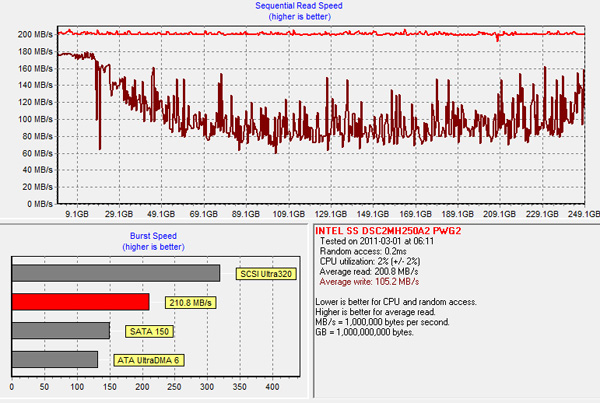
Once tortured the 510's performance drops as far down as 60MB/s for writes. A single TRIM pass restores performance to an almost-new state:

Worst case sequential performance isn't terrible, but worst case random write performance is pretty bad. Remember the ~50MB/s speeds from earlier? Those will drop down to ~5MB/s with an adequately fragmented drive. TRIM will recover performance but write amplification goes through the roof if you have a highly random workload. The 510 is suitable for desktop workloads, but anything more enterprise-like may be out of the question (at least not without significantly increasing the amount of spare area). I'm currently testing the 510 in a Mac to see how performance fares without TRIM over time.
Final Words
The first time Intel told me it would be using a 3rd party controller in one of its upcoming SSDs I bit my tongue. Intel tried to justify the decision but all I heard in my head was that Intel was bowing out of the high end race, that Elmcrest was a copout. I have to admit I was wrong. I assumed that Elmcrest wouldn't be even remotely competitive. In reality, the Intel SSD 510 may not be the fastest SATA SSD we've ever tested, but it comes very close. Overall performance is within striking distance of the Vertex 3 and depending on the test, performance can actually be a little higher than the clever competitor. Note that I've only tested the 250GB drive. Intel's 120GB SSD 510 should be measurably slower.
The 510 is most interesting over a 6Gbps interface. Connected to a 3Gbps interface the drive is quick, but fails to distance itself from the high end drives of last year. This is the same conclusion I came to when I previewed the Vertex 3. These next-generation SSDs not only use 6Gbps SATA, they really need it.
My biggest complaints about the 510 actually aren't about Intel's use of a 3rd party controller, instead they are about the drive's lackluster random read performance. In a horrible bout of irony Intel fixed its sequential performance and moved backwards in the random department. Random read performance, as it turns out, has a pretty major impact in the real world.
Random write performance is also pretty low by today's standards, however the impact on most of our real world performance tests is minimal. It looks like we may have hit the upper limit of what we need from 4KB random write performance (at least given current workloads).
Sequential performance is easily competitive with the Vertex 3, and when presented with incompressible data the Intel SSD 510 is easily faster.
Overall OCZ's Vertex 3 is faster, however the margin of victory isn't always significant. Intel would argue that its drive is better tested and less likely to fail. Whether this is true remains to be seen, but history does count for something.
As always, it'll be months before we have a good idea of compatibility, reliability and any long term issues. In typical AnandTech fashion I've already deployed the Intel SSD 510 in a primary use system. The big advantage Intel has today is that its drive is currently available and it seems to work. The performance is good and close enough to the Vertex 3 that if the drive does end up being more reliable Intel could have a winner on its hands.
At the same time, OCZ has been investing tremendously in improving manufacturing quality and validation testing. If the Vertex 3 can launch without any major firmware bugs, reliability or manufacturing issues, Intel's SSD 510 may not have a leg to stand on.
Then we have the other Marvell based designs from Corsair and Crucial/Micron. The 2011 SSD market is just starting to heat up...
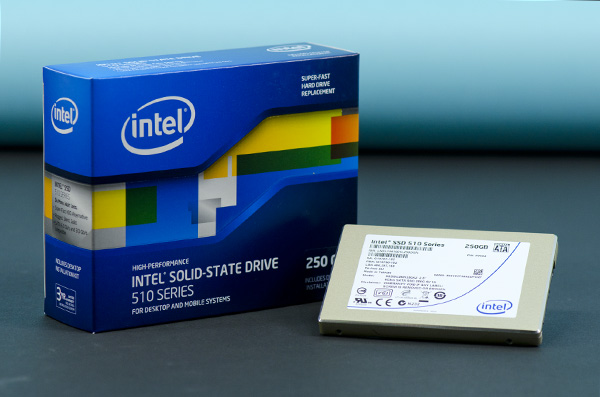

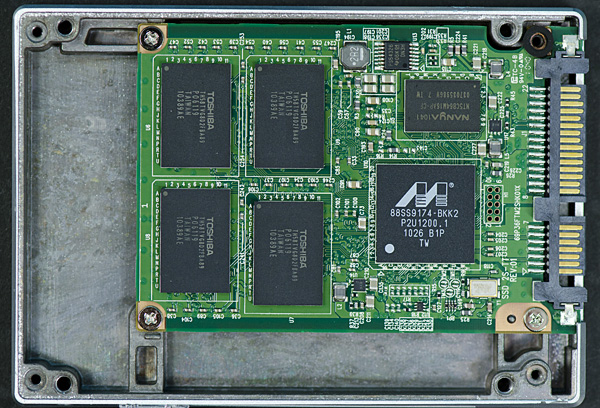


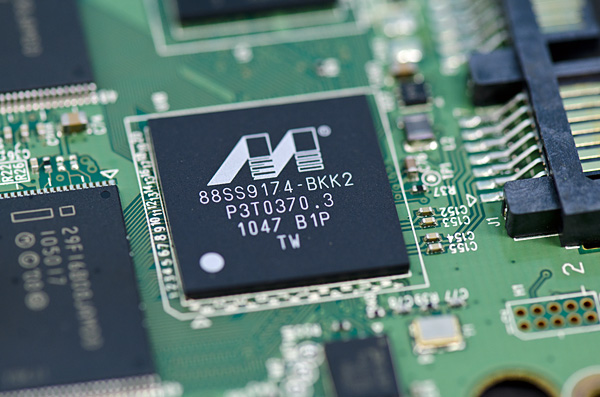
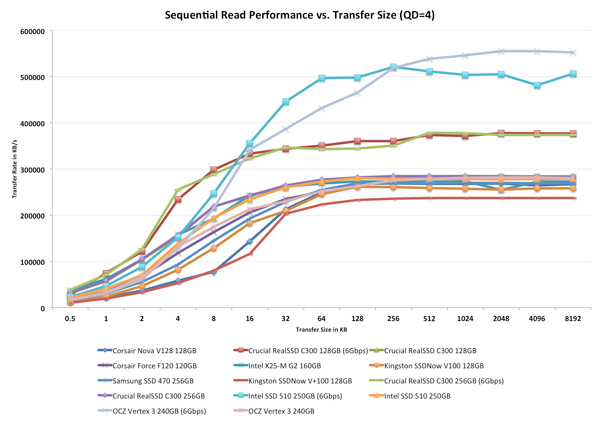
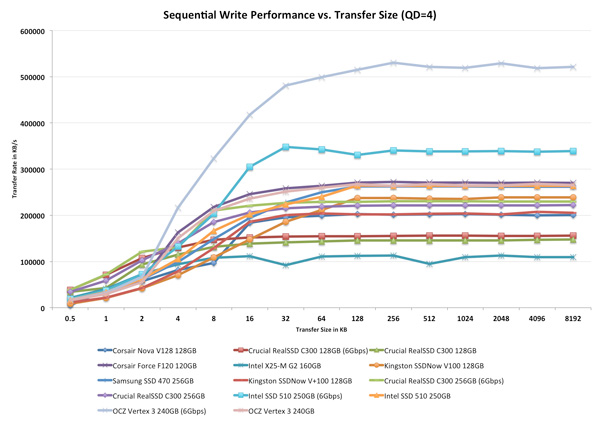

0 comments:
Post a Comment